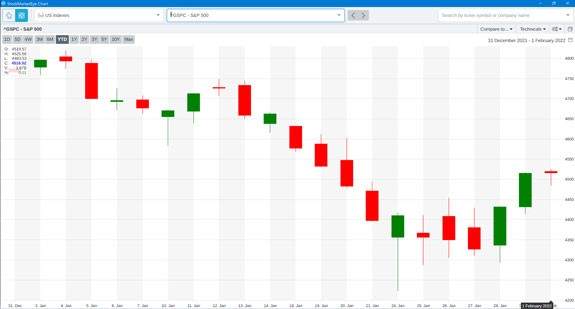You wanna make money in the stock market?
Then ignore the stock market.
The trading sessions that bracketed this past weekend are a case in point.
You can spot them easily in the chart below. They’re the two big green candlesticks on the right-hand side. They produced the biggest two-session gain since April 2020:

(Click here to view larger image.)
My reaction to those big up days was probably like yours.
Momentum (aka growth) stocks in The Bauman Letter’s model portfolio have taken a beating since the beginning of the year. So has my personal portfolio.
So, when those stocks jumped like a frog off a hot highway on Friday and Monday, I breathed a sigh of relief.
“The worst must be over. The smart money is piling back in.”
That’s what I wanted to think.
But the facts tell a different story … and prove why smart investors ignore short-term moves like these.
What Exactly IS the Stock Market?
To see why, ask yourself how the stock market works.
The popular image of the stock market is this guy (who has been in more stock photos than I can count):

He’s an individual trader on the floor of the New York Stock Exchange. He’s watching real-time data with his own eyes and executing trades with his own hands. He’s just one of many traders doing the same thing. Together, their trading decisions produce the prices we all follow every day.
But this is an illusion.
The United States is the only country that still uses the so-called open outcry system of live in-person trading. Even so, only about 5% of trades happen this way.
Most stock trades are electronic. But even then, trading of stocks between investors who want to own them and those who don’t is a minority of the action.
In fact, some of the most consequential trading — the transactions that produce days like Friday and Monday — happens between parties who aren’t interested in owning stocks at all.
Market Makers Make the Market
The fact that most stock trading happens electronically likely isn’t news to you.
You’ve probably heard of “high-frequency trading,” “algorithmic strategies” and “quants.” They’re computer-based approaches to buying and selling of individual stocks. No physical eyes or hands involved.
Whether the goal is to trade ultrafast to capture small differences that fat-fingered humans can’t, or to employ fixed rules designed to create a tiny edge on huge trades, the idea is to use computing power to get better returns on stock ownership.
But increasingly — and especially over the last two years — there’s been a massive increase in trading volume … and it’s all about the options market.
When you buy a call option, you’re betting that the price of a stock will increase to a certain amount by a given date. But somebody else must take the other side of that bet. That’s called a market maker.
Market makers are huge trading houses. They own stocks not because they want them for themselves, but so they can facilitate transactions between other investors. They make money by exploiting the difference between bids and asks — the price buyers and sellers set with their own trading activity.
Because market makers have lots of stock in inventory, they can also sell (aka “write”) options on them.
For example, if you buy call options on Microsoft (Nasdaq: MSFT) stock, you’re betting that it will rise to a certain “strike” price by a set date. If it does, you profit. If it doesn’t, the market maker who sold you the option profits.
That sets up powerful incentives for the market maker.
They don’t want to see MSFT rise to the strike price. So, they have an incentive to sell it in volume to suppress its price. If enough market makers do this, it can artificially suppress the stock price below what would be set between buyers and sellers without options involved. That can create downward momentum for a stock that has nothing to do with its intrinsic value.
On the other hand, if it looks like MSFT is going to rise to its strike price, market makers have an incentive to buy more of it to hedge against the possibility that they will have to deliver it when the options expire. It’s better to buy the stock at a price below the strike price to limit your losses.
That in turn creates an upward pressure on MSFT, as market makers accumulate the stock as a hedge against the expiring call options they’ve written.
It’s a self-fulfilling prophecy. As market makers buy MSFT to hedge against it rising to its strike price, they push it ever closer to that price … leading to even more hedge buying.
Rise of the Derivatives
In late 2021, the volume of options traded exceeded that of stocks traded for the first time:

(Click here to view larger image.)
As market momentum decelerated in the second half of the year, retail traders who had cut their teeth on the meme stock mania turned to call options. Market makers “stocked up” on those equities to hedge their positions. That tended to push up their price.
But the collapse of the momentum trade starting in mid-December led to a countertrend. Short sellers began to borrow these same stocks with the expectation that their prices would fall.
Those two trends collided on Friday and Monday.
Market makers bought stocks to ensure they didn’t lose money on call options expiring Friday. Short sellers saw the resulting price increase and jumped in to buy the same stocks to avoid losing money on their short trades.
The result was a perfect storm of price action that had nothing to do with the stocks themselves.
There was no funny little guy with frizzy white hair and a clipboard trading stocks. There was just a massive realignment of derivative positions by financial institutions out to make a quick buck.
I’m pretty sure that some people jumped in and bought stocks based on those “artificial” price conditions.
Time will tell … but I suspect they would have been better off ignoring the stock market until later this week.
Kind regards,

Ted Bauman
Editor, The Bauman Letter



